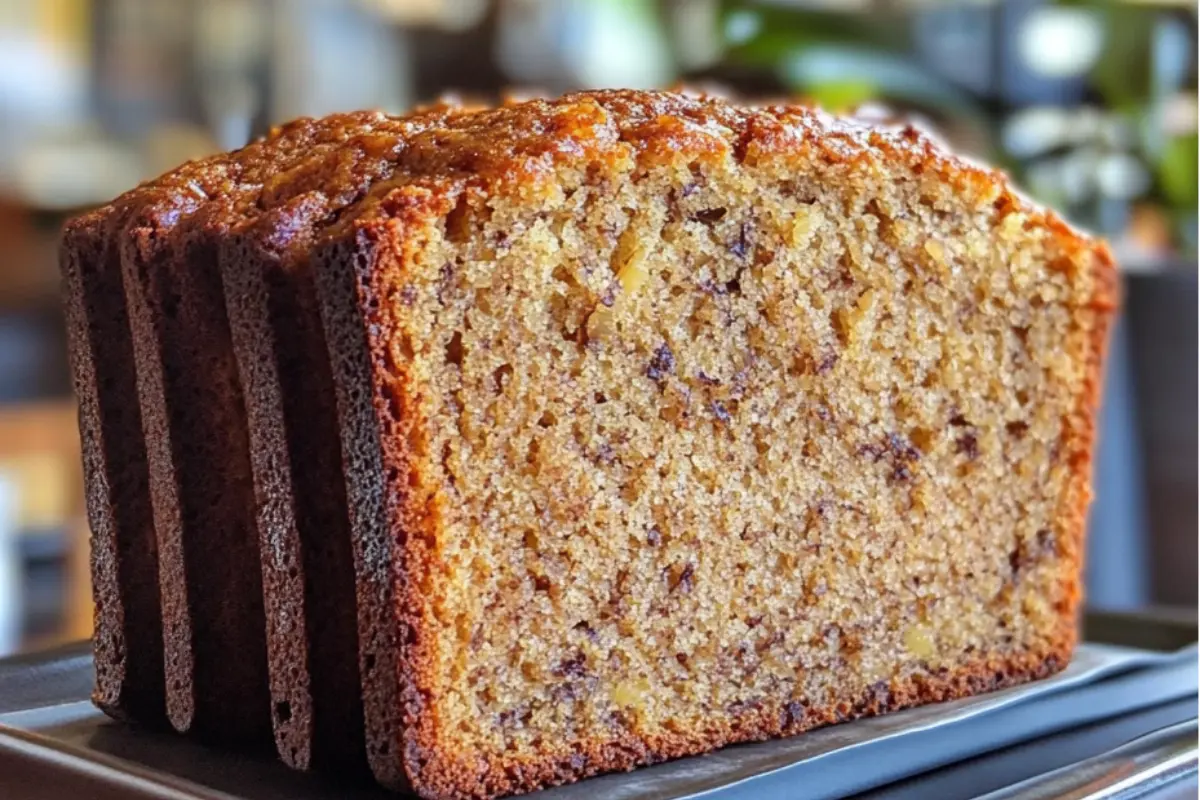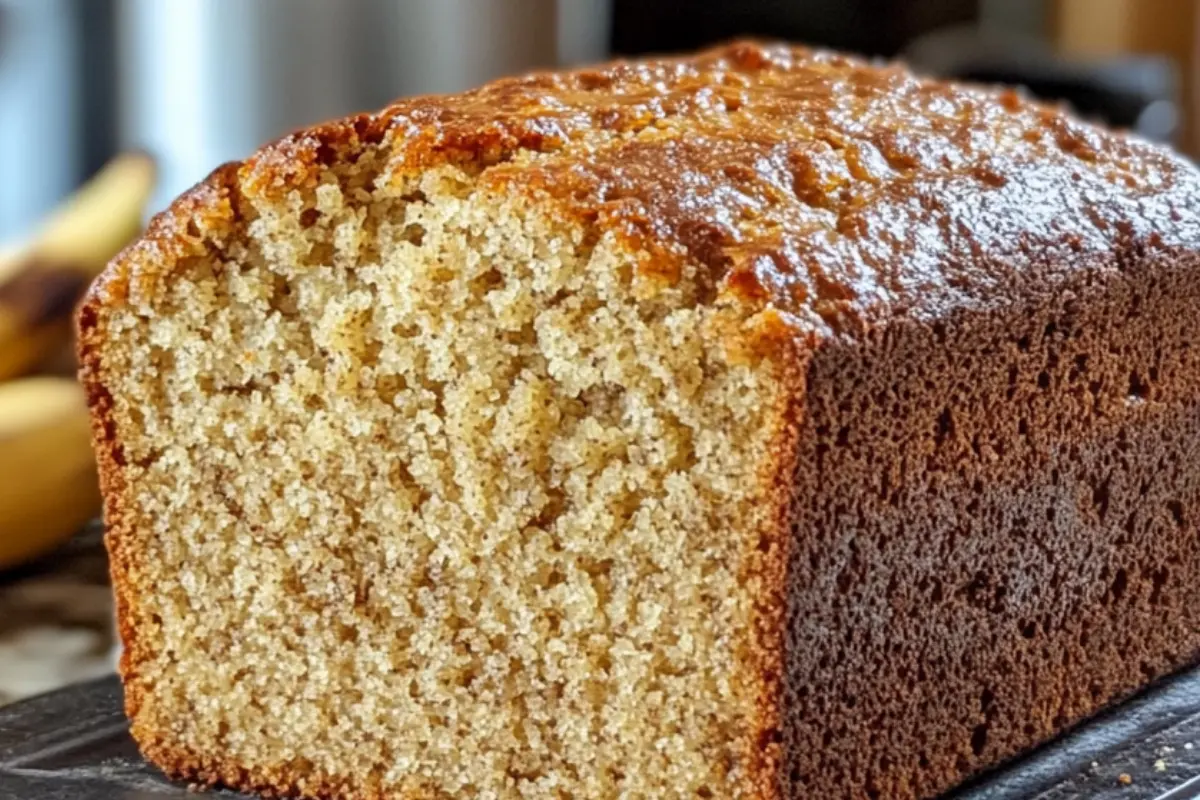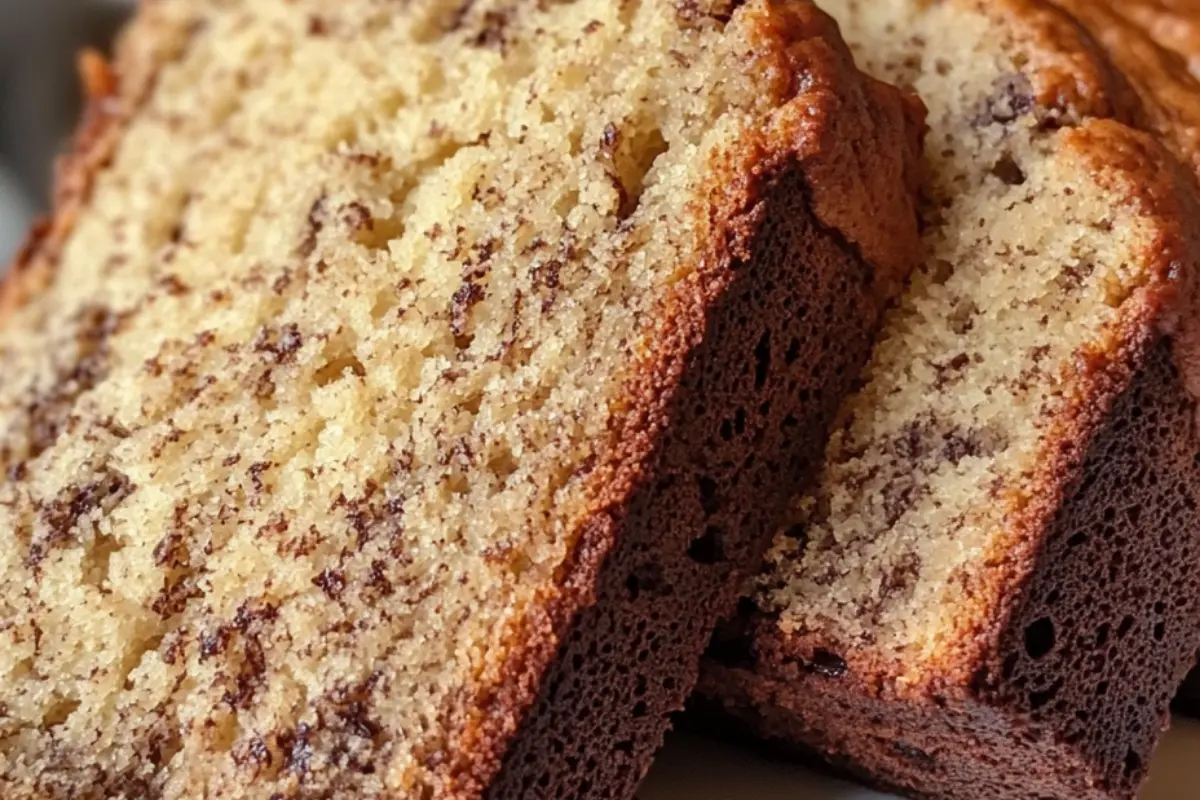Banana bread is one of those recipes that everyone needs in their repertoire. It’s forgiving, easy to customize, and always a crowd-pleaser. But what makes a banana bread truly exceptional? The key lies in the right combination of ingredients and technique. With this recipe, you’ll learn how to balance sweetness, moisture, and texture to create a banana bread that’s moist, tender, and packed with banana flavor.
Ingredients for Moist Banana Bread
To make the best banana bread, you need the right ingredients. Each component plays a crucial role in the texture and flavor of the final product.
Essential Ingredients
- Overripe Bananas: The star of the show! Overripe bananas are sweeter and more flavorful, making them perfect for banana bread. The more spots on the peel, the better.
- All-Purpose Flour: A versatile choice that provides the right structure. You can also use whole wheat flour for a nuttier flavor, but it might slightly affect the texture.
- Baking Soda: This is the leavening agent that helps your banana bread rise. Make sure it’s fresh for the best results.
- Butter or Oil: Fat adds moisture and richness to the bread. While butter gives a better flavor, oil will make the bread even moister.
- Brown Sugar: Adds sweetness and a hint of molasses flavor, which pairs wonderfully with bananas.
- Eggs: They bind everything together and add richness.
- Vanilla Extract: Enhances the overall flavor with a warm, sweet note.
- Salt: A pinch of salt balances the sweetness and deepens the flavors.
Why Overripe Bananas are Key
Using overripe bananas is crucial for a moist banana bread. As bananas ripen, their starches convert to sugars, making them sweeter and more flavorful. Overripe bananas also have a softer texture, which blends smoothly into the batter, ensuring your bread stays moist.
Step-by-Step Guide to Make Banana Bread Moist
Achieving the perfect moist banana bread is all about the right technique. Follow these steps closely, and you’ll have a loaf that’s tender and full of flavor.
 Step 1: Prepare Your Ingredients
Step 1: Prepare Your Ingredients
Before you start, make sure all your ingredients are at room temperature. This helps them blend more evenly, resulting in a smoother batter.
- Mash the Bananas: In a large bowl, mash your overripe bananas with a fork until smooth. Some small lumps are fine as they add texture to the bread.
- Mix the Wet Ingredients: Add melted butter (or oil), brown sugar, and vanilla extract to the mashed bananas. Stir until everything is well combined.
- Beat in the Eggs: Add the eggs one at a time, beating well after each addition. This ensures the batter is smooth and airy.
Step 2: Combine Dry Ingredients
In a separate bowl, whisk together the flour, baking soda, and salt. This step is crucial for evenly distributing the leavening agent, which helps the bread rise properly.
- Gradually Add Dry Ingredients to Wet: Slowly mix the dry ingredients into the wet mixture. Stir just until combined—overmixing can make the bread tough.
- Optional Add-Ins: If you like, fold in nuts, chocolate chips, or dried fruits at this stage. These add-ins can give your banana bread a delightful twist.
Step 3: Bake to Perfection
- Preheat Your Oven: Set the oven to 350°F (175°C) and grease a 9×5-inch loaf pan.
- Pour the Batter: Pour the batter into the prepared loaf pan, smoothing the top with a spatula.
- Bake: Place the pan in the preheated oven and bake for 60-65 minutes. To check if it’s done, insert a toothpick into the center—if it comes out clean or with a few moist crumbs, your bread is ready.
- Cool Before Slicing: Let the banana bread cool in the pan for 10 minutes before transferring it to a wire rack to cool completely. This helps set the structure, making it easier to slice.
The Best Flour for Banana Bread
Flour is a key ingredient in banana bread, as it provides the structure that holds everything together. However, not all flours are created equal, and the type you use can significantly impact the texture and flavor of your bread.
All-Purpose Flour: The Classic Choice
Most traditional banana bread recipes call for all-purpose flour. This flour is a great all-around option because it provides the perfect balance of structure and tenderness. It has just enough gluten to hold the bread together without making it too dense.
Whole Wheat Flour: A Healthier Alternative
If you want to add a bit more fiber and a nutty flavor to your banana bread, you can substitute all-purpose flour with whole wheat flour. Keep in mind that whole wheat flour can make your bread a bit denser, so it’s a good idea to use it in combination with all-purpose flour or add a bit more moisture to the batter by increasing the amount of banana or liquid ingredients.
Gluten-Free Options
For those who need to avoid gluten, there are plenty of gluten-free flours available that work well in banana bread. A popular option is a gluten-free all-purpose flour blend, which is usually a mix of rice flour, potato starch, and other gluten-free ingredients. These blends are designed to mimic the properties of regular flour, giving you a similar texture and rise.
Avoiding Dense Banana Bread
Dense banana bread is often the result of common mistakes in the baking process. However, with a few simple adjustments, you can ensure your bread turns out light, fluffy, and delicious every time.
Don’t Overmix the Batter
One of the most crucial tips is to avoid overmixing your batter. When you overmix, you activate the gluten in the flour too much, which leads to a tougher, denser loaf. To prevent this, gently fold the dry ingredients into the wet ingredients just until combined. It’s okay if there are a few lumps; they’ll disappear during baking.
Use the Right Amount of Baking Soda
Baking soda is what helps your banana bread rise and become light and airy. Using too little can result in a dense loaf, while too much can cause the bread to rise too quickly and then collapse. Stick to the amount called for in the recipe and make sure your baking soda is fresh. If it’s been sitting in your pantry for a while, it might not be as effective.
Properly Measure Your Flour
Another common mistake is using too much flour, which can make the bread dense and dry. To avoid this, spoon the flour into your measuring cup and level it off with a knife, rather than scooping it directly from the bag, which can pack the flour and lead to using more than intended.
Don’t Overbake
Overbaking can dry out your banana bread, making it dense and crumbly. Check your bread a few minutes before the recommended baking time is up. Insert a toothpick into the center—if it comes out with a few moist crumbs, your bread is done. Remember that it will continue to cook a little as it cools.
 Frequently Asked Questions about Banana Bread
Frequently Asked Questions about Banana Bread
Banana bread is a simple recipe, but it often brings up a few questions, especially for those trying to perfect their loaf. Let’s dive into some of the most commonly asked questions to help you make the best banana bread possible.
Can I Use Overripe Bananas for Banana Bread?
Absolutely! Overripe bananas are ideal for banana bread. The browner and spottier the bananas, the better they’ll be for your bread. As bananas ripen, they become sweeter and softer, which helps create a moist, flavorful loaf. If your bananas are too ripe to eat, they’re just right for banana bread.
How Do You Make Banana Bread Moist?
To make banana bread moist, it’s crucial to use enough fat (like butter or oil) and the right amount of ripe bananas. Overripe bananas add natural moisture and sweetness, while the fat ensures a tender crumb. Also, avoid overbaking, as this can dry out your bread.
What’s the Best Flour for Banana Bread?
The best flour for banana bread is typically all-purpose flour. It provides the right balance of structure and tenderness. If you’re looking for a healthier option, you can use whole wheat flour or a gluten-free blend, but be aware that these may affect the texture slightly.
How Do You Prevent Banana Bread from Being Dense?
Preventing dense banana bread comes down to a few key practices: avoid overmixing the batter, use the correct amount of leavening agents (like baking soda), measure your flour properly, and ensure you don’t overbake. These steps will help you achieve a light, fluffy loaf.
Can I Freeze Banana Bread?
Yes, banana bread freezes beautifully! Once your bread has completely cooled, wrap it tightly in plastic wrap and then in aluminum foil, or place it in a freezer-safe bag. It can be frozen for up to three months. To enjoy, let it thaw at room temperature or warm it in the oven.
Variations and Add-ins for Banana Bread
One of the best things about banana bread is how versatile it is. With just a few tweaks, you can create a variety of flavors and textures that suit your taste. Here are some popular variations and add-ins to consider.
Classic Add-ins
- Chocolate Chips: Chocolate and banana are a match made in heaven. Stir in a cup of semi-sweet or dark chocolate chips for a sweet, indulgent twist.
- Nuts: Chopped walnuts or pecans add a satisfying crunch to your banana bread. Toast them first to enhance their flavor.
- Dried Fruits: Add dried cranberries, raisins, or chopped dates for bursts of sweetness throughout the loaf.
Healthier Variations
- Whole Wheat Banana Bread: Substitute half or all of the all-purpose flour with whole wheat flour for a heartier, more nutritious loaf. You might need to increase the liquid slightly to compensate for the denser flour.
- Lower Sugar Option: Reduce the amount of sugar in the recipe, and let the natural sweetness of the bananas shine through. You can also use honey or maple syrup as a natural sweetener.
- Vegan Banana Bread: Replace the eggs with flax eggs (1 tablespoon of ground flaxseed mixed with 3 tablespoons of water per egg) and use coconut oil or a plant-based butter substitute instead of regular butter.
Flavorful Twists
- Cinnamon Swirl Banana Bread: Mix some cinnamon and sugar and swirl it into the batter before baking for a fragrant, spiced loaf.
- Peanut Butter Banana Bread: Add a swirl of peanut butter to the batter for a rich, nutty flavor that pairs perfectly with bananas.
- Banana Coconut Bread: Stir in shredded coconut for a tropical twist. You can even add a bit of coconut extract for extra flavor.
Creative Toppings
- Streusel Topping: Combine flour, brown sugar, and butter to create a crumbly topping that adds a sweet, crunchy layer to your bread.
- Glaze: Drizzle a simple powdered sugar glaze over the top of your cooled banana bread for a sweet finish.
- Banana Slices: Top your batter with thin slices of banana before baking for a decorative and tasty touch.
Troubleshooting Common Issues with Banana Bread
Even with the best recipe and intentions, banana bread can sometimes pose a few challenges. Here are some common issues you might encounter and how to solve them.
Why Is My Banana Bread Dry?
Dry banana bread can result from several factors. Overbaking is a common culprit—be sure to check your bread a few minutes before the recommended time, as ovens can vary. Also, make sure you’re using the correct amount of fat and bananas, as these ingredients contribute to the moisture in the bread. Another tip is to measure your flour carefully; too much flour can dry out the batter.
Why Didn’t My Banana Bread Rise Properly?
If your banana bread is flat or dense, it might be due to old baking soda. Baking soda loses its potency over time, so always check the expiration date before using it. Additionally, make sure you’re not overmixing the batter, which can deflate the air bubbles needed for a good rise.
Why Is My Banana Bread Too Dense?
Dense banana bread often occurs when the batter is overmixed, which develops too much gluten and results in a tougher loaf. Another possibility is using too much flour—again, proper measuring is key. Lastly, check your leavening agent; if it’s not fresh, your bread may not rise as expected, leading to a denser texture.
Why Is My Banana Bread Sinking in the Middle?
If your banana bread sinks in the middle, it could be due to underbaking. Make sure the center of the loaf is fully cooked before removing it from the oven. Another reason could be too much moisture in the batter, often caused by using overly large bananas or too many liquid ingredients. Lastly, sudden temperature changes (like opening the oven door too often) can cause the bread to collapse.
What Can I Do If My Banana Bread Is Burnt on the Outside but Undercooked Inside?
This issue typically arises when the oven temperature is too high. The outside of the bread cooks too quickly, while the inside remains underdone. To fix this, reduce the oven temperature by 25°F (about 15°C) and bake for a longer time. Covering the bread loosely with aluminum foil during the last 15 minutes of baking can also help prevent over-browning while the inside finishes cooking.
Conclusion
Making the perfect banana bread is all about balancing the right ingredients with careful technique. By using overripe bananas, the proper flour, and following the steps outlined in this guide, you’ll be able to bake a loaf that’s moist, flavorful, and never too dense. Don’t be afraid to experiment with add-ins and variations to make the recipe your own. And if something doesn’t go quite right, now you have the troubleshooting tips to fix it!
With this comprehensive guide in hand, you’re ready to bake banana bread that will impress everyone who tries it. Whether you stick to the classic recipe or add your twist, this banana bread will surely become a favorite in your household.
- Use overripe bananas for maximum flavor and moisture.
- Avoid overmixing to prevent a dense loaf.
- Experiment with add-ins like chocolate chips, nuts, or spices for a personalized touch.
- Remember to check for doneness before removing the bread from the oven.
Now that you’ve got all the secrets to making perfect banana bread, what will you add to your loaf? Share your favorite variations or let us know how your banana bread turned out in the comments below!


 Step 1: Prepare Your Ingredients
Step 1: Prepare Your Ingredients Frequently Asked Questions about Banana Bread
Frequently Asked Questions about Banana Bread

